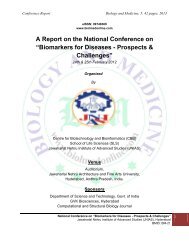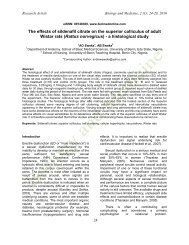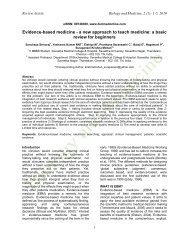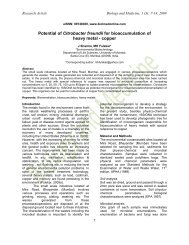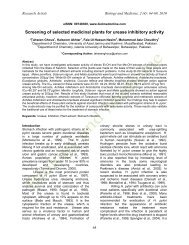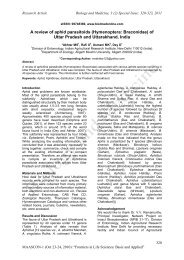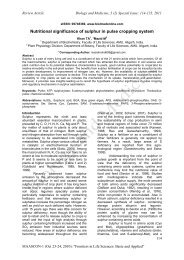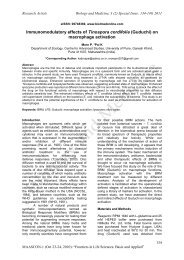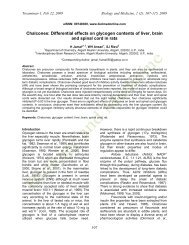Seasonal and spatial distribution of Brachionus - Biology and ...
Seasonal and spatial distribution of Brachionus - Biology and ...
Seasonal and spatial distribution of Brachionus - Biology and ...
Create successful ePaper yourself
Turn your PDF publications into a flip-book with our unique Google optimized e-Paper software.
Research Article <strong>Biology</strong> <strong>and</strong> Medicine, 3 (2) Special Issue: 60-69, 2011<br />
eISSN: 09748369, www.biolmedonline.com<br />
<strong>Seasonal</strong> <strong>and</strong> <strong>spatial</strong> <strong>distribution</strong> <strong>of</strong> <strong>Brachionus</strong> (Pallas, 1966;<br />
Eurotatoria: Monogonanta: Brachionidae), a bioindicator <strong>of</strong><br />
eutrophication in lake El-Manzalah, Egypt<br />
Mola HRA<br />
National Institute <strong>of</strong> Oceanography <strong>and</strong> Fisheries, 101, Kasr El-Einy St, Cairo, Egypt.<br />
Correspondence: hesham_reda06@yahoo.com<br />
Abstract<br />
Rotifers, especially <strong>Brachionus</strong> sp., are the major component <strong>of</strong> zooplankton in Egyptian eutrophic lakes. These<br />
species play an important role as bioindicator in these aquatic environments. In present study, twenty-four<br />
zooplankton samples were collected <strong>and</strong> investigated along six stations <strong>of</strong> southeastern sector <strong>of</strong> the lake from<br />
August 2009 to May 2010. <strong>Brachionus</strong> sp. were the most abundant species constituting 74.8 % <strong>of</strong> the total rotifers<br />
<strong>and</strong> 59.87 % <strong>of</strong> the total zooplankton. It was represented by 7 species which are; <strong>Brachionus</strong> angularis, B.<br />
budapestinensis, B. calyciflorus, B. caudatus, B. plicatilis, B. urceolaris <strong>and</strong> B. quadridentatus. The highest<br />
abundance <strong>of</strong> <strong>Brachionus</strong> sp. was recorded at Ibn Salam Station (4227493 Org./m 3 ) during summer due to the effect<br />
<strong>of</strong> water discharge rich in nutrients through 3 main drains in this area while the lowest abundance was recorded at El-<br />
Qaboti Station (333 Org./m 3 ) during winter. <strong>Brachionus</strong> angularis <strong>and</strong> B. calyciflorus formed collectively (92.16 % <strong>of</strong><br />
the total <strong>Brachionus</strong> sp.). The presence <strong>of</strong> these species <strong>of</strong> <strong>Brachionus</strong> in high composition indicates eutrophication<br />
<strong>of</strong> Lake El-Manzalah.<br />
Keywords: <strong>Brachionus</strong>; Eutrophication; Lake; Egypt.<br />
Introduction<br />
Lake El-Manzalah, the largest <strong>and</strong> the most<br />
productive <strong>of</strong> the Egyptian Delta lakes is<br />
considered as one <strong>of</strong> the essential sources <strong>of</strong><br />
fisheries in Egypt. It has contributed nearly 50 %<br />
<strong>of</strong> the total country yield during early 1970s <strong>and</strong><br />
about 35 % during 1980s (Bishai <strong>and</strong> Yossef,<br />
1977; Khalil <strong>and</strong> Salib, 1986). The lake is<br />
situated in the north-eastern extremity <strong>of</strong> the Nile<br />
Delta. It lies between longitude 31 o : 45 \ -32 o -50 \<br />
E <strong>and</strong> latitude 31 o : 00- 31 o : 35 \ N (Moati <strong>and</strong><br />
Dowidar, 1988; El-Bokhty, 1996; Mageed,<br />
2008).<br />
The lake is bounded by the<br />
Mediterranean Sea to the North, Suez Canal to<br />
the East, <strong>and</strong> Damietta Branch to the West (Fig.<br />
1). The southern shores <strong>of</strong> the lake form the<br />
north boundary <strong>of</strong> Dakahiliya <strong>and</strong> Sharkiya<br />
Governorates. The lake is connected with the<br />
Mediterranean Sea by narrow s<strong>and</strong>y fringes<br />
namely El-Gamil, New El-Gamil, El -Boughdady<br />
<strong>and</strong> New Damietta Boughases (El-Enany, 2004).<br />
The lake is also connected with Suez Canal at<br />
Qabouti, few kilometers to the South <strong>of</strong> Port<br />
Said. The north-western side <strong>of</strong> the lake is<br />
connected with Damietta Branch <strong>of</strong> the River<br />
Nile by El-Souffra <strong>and</strong> El-Ratma Canals, north <strong>of</strong><br />
Damitta City.<br />
The isl<strong>and</strong>s in the lake divided it into<br />
several regions known to the local fishermen as<br />
Bohours. Each <strong>of</strong> them has more or less<br />
distinctive ecological character (Shehata, 1982;<br />
Abdel Moati <strong>and</strong> Dowidar, 1988; El-Bokhty,<br />
1996). The lake is probably the shallowest <strong>of</strong> the<br />
Delta lakes <strong>and</strong> the rich food supply it contains<br />
render it excellent feeding <strong>and</strong> breeding ground<br />
for many species <strong>of</strong> fishes, except those fishes<br />
that perform annually a breeding migration to the<br />
sea like mullets <strong>and</strong> shrimps.<br />
Zooplanktons are good indicators <strong>of</strong><br />
particular environmental conditions <strong>and</strong> their<br />
change as revealed by many studies.<br />
Zooplankton has been used as indicator <strong>of</strong> water<br />
quality for a long time. Some species flourish in<br />
highly eutrophic waters while others are very<br />
sensitive to organic or chemical wastes (El-<br />
Enany, 2009). Rotifers constituted the main food<br />
<strong>of</strong> animal origin for the Cichlid species (Hegab,<br />
2010). Rotifers, especially <strong>Brachionus</strong>,<br />
constitute an important link in the food chains <strong>of</strong><br />
inl<strong>and</strong> waters. They are considered preferred<br />
food for many fish larvae (Guerguess, 1993).<br />
Eutrophication can be defined as<br />
nutrient <strong>and</strong> organic matter enrichment or both<br />
that results in high biological productivity or<br />
decrease in volume within an ecosystem (Likens<br />
<strong>and</strong> Bormann, 1972). Eutrophication was found<br />
to affect zooplankton composition, shifting the<br />
dominance from large species (Copepoda) to<br />
smaller species (Rotifera) (El-Shabrawy, 2000;<br />
Emam, 2006). El-Enany (2004) mentioned that<br />
the southeastern part <strong>of</strong> Lake El-Manzalah is<br />
MAASCON-1 (Oct 23-24, 2010): “Frontiers in Life Sciences: Basic <strong>and</strong> Applied”<br />
60
Research Article <strong>Biology</strong> <strong>and</strong> Medicine, 3 (2) Special Issue: 60-69, 2011<br />
highly enriched than any other part <strong>of</strong> the lake<br />
due to the effect <strong>of</strong> drains in this area. Rotifers,<br />
especially <strong>Brachionus</strong> plicatilis, formed the most<br />
dominant species in the eutrophic water body<br />
which referred to the influence <strong>of</strong> eutrophication.<br />
Zooplankton <strong>of</strong> the lakes was studied by<br />
El-Maghraby et al., (1963), Guerguess (1979),<br />
MacLaren (1982), Guerguess (1993), El-Sherif<br />
et al. (1994), Khalifa <strong>and</strong> Mageed (2002) <strong>and</strong><br />
Mageed (2008). Hence, it was considered<br />
desirable to focus in this study on the<br />
<strong>Brachionus</strong> sp. which was collected seasonally<br />
from several sites from August 2009 to May<br />
2010, so that the aim <strong>of</strong> the present work is to<br />
estimate seasonal variations <strong>and</strong> <strong>spatial</strong><br />
<strong>distribution</strong>s <strong>of</strong> recorded <strong>Brachionus</strong> species as<br />
a bioindicator for eutrophication <strong>of</strong> one <strong>of</strong> the<br />
most eutrophic lakes in Egypt in relation to some<br />
environmental factors (water temperature,<br />
transparency, conductivity, pH, <strong>and</strong> dissolved<br />
oxygen) in order to determine which one <strong>of</strong><br />
these species could be used as indicator for<br />
eutophication.<br />
Materials <strong>and</strong> Methods<br />
Stations sampled<br />
On the basis <strong>of</strong> ecology, six stations were<br />
selected <strong>and</strong> described from the southeastern<br />
part <strong>of</strong> the lake (Figure 1). This part <strong>of</strong> the lake<br />
was affected by many drains as follows:<br />
Station 1 (Qaboti): Few kilometers from Port<br />
Said City.<br />
Station 2 (El-Bashtir): Located in Bahr El-<br />
Bashtir, 7 km from Qaboti.<br />
Station 3 (Bahar El-Bakar): At the discharge<br />
point <strong>of</strong> New Bahr El-Bakar drain.<br />
Station 4 (El Boom): At the main channel west <strong>of</strong><br />
Bahr El-Bakar drain.<br />
Station 5 (Ibn Salam): At Bahr El-Genka in front<br />
<strong>of</strong> Ibn Salam isl<strong>and</strong>. Three main drains (Hadous,<br />
Ramsis <strong>and</strong> Old Bahr El-Bakar) discharge in this<br />
area.<br />
Station 6 (El-Matariya): It is located in the front<br />
<strong>of</strong> El-Matariya City.<br />
Collection <strong>and</strong> analysis <strong>of</strong> samples<br />
Water samples <strong>and</strong> zooplankton samples were<br />
taken seasonally during the period from August<br />
2009 to May 2010 from 6 stations at the same<br />
time during the four successive seasons<br />
(summer, autumn, winter <strong>and</strong> spring).<br />
Air <strong>and</strong> water temperature were<br />
measured in shade during the time <strong>of</strong> sampling<br />
using a mercury thermometer graduated to 100<br />
0 C. Transparency <strong>of</strong> water (represented by Cm)<br />
column was determined using black <strong>and</strong> white<br />
enamel coated Secchi Disk with a diameter <strong>of</strong><br />
20 cm. Electrical conductivity (EC) was<br />
measured by the conductivity meter (model YSI<br />
SCT-33). The results are expressed as (µS/cm).<br />
Hydrogen ion concentration (pH) was directly<br />
measured by pH meter (model Jenway 3150).<br />
Dissolved oxygen was determined by<br />
modified Winkler method (APHA, 1992).<br />
Zooplankton collection was carried out<br />
by filtration <strong>of</strong> 30 liters from the surface with a<br />
plankton net 55 µ, 25 cm diameter <strong>and</strong> 80 cm<br />
length. All samples were immediately fixed with<br />
4 % formalin. In the laboratory, the samples<br />
were examined with Optic Research<br />
Microscope. Three subsamples (1 ml for each)<br />
<strong>of</strong> the homogenized plankton samples were<br />
transferred to accounting cell <strong>and</strong> the different<br />
plankters were counted. Zooplankton population<br />
was then calculated as the number <strong>of</strong> individuals<br />
<strong>of</strong> the different species per cubic meter.<br />
Planktonic organisms were classified, identified<br />
<strong>and</strong> described according to description <strong>and</strong> keys<br />
constructed by Edmondson (1966), Ruttner-<br />
Kolisko (1974), Pennak (1978), Pontin (1978)<br />
<strong>and</strong> Shehata et al. (1998a,b). Cluster analysis<br />
(similarity index) <strong>and</strong> correlation coefficient were<br />
carried out on data <strong>of</strong> <strong>Brachionus</strong> species <strong>and</strong><br />
physico-chemical parameters at selected<br />
stations by MINITAB 12 on Windows.<br />
Results <strong>and</strong> Discussion<br />
1- Physico-chemical properties<br />
The variations <strong>of</strong> water temperature (Table 1)<br />
showed agreement with air temperature. The<br />
highest temperature was recorded during<br />
summer (34 0 C) <strong>and</strong> the lowest during winter (13<br />
0 C). Transparency ranged between 17 cm at<br />
Bahr El-Bakar station during winter due to the<br />
effect <strong>of</strong> drains which carry high amount <strong>of</strong><br />
organic <strong>and</strong> suspended matter in this mixing<br />
point while the highest reading was recorded at<br />
Ibn Salam station (49 cm) during spring. Also,<br />
pH recorded its lowest value (6.98) at Bahr El-<br />
Bakar station during spring, the relative<br />
decrease <strong>of</strong> ph values in this station due to the<br />
effect <strong>of</strong> Bahr El-Bakar drain (Abdel-Satar, 2001)<br />
<strong>and</strong> the highest (8.64) was recorded at Qaboti<br />
Station during winter. Dissolved oxygen<br />
recorded its minimum values at Bahr El-Bakar<br />
being 2.20, 2.90 2.79 <strong>and</strong> 2.10 mg/l during<br />
MAASCON-1 (Oct 23-24, 2010): “Frontiers in Life Sciences: Basic <strong>and</strong> Applied”<br />
61
Research Article <strong>Biology</strong> <strong>and</strong> Medicine, 3 (2) Special Issue: 60-69, 2011<br />
summer, autumn, winter <strong>and</strong> spring,<br />
respectively. This may be attributed to the effect<br />
<strong>of</strong> pollution by sewage <strong>and</strong> agricultural wastes<br />
discharged, as well as, biochemical composition<br />
<strong>of</strong> organic matter leads to increasing ammonia<br />
<strong>and</strong> sulphids causes mineralization <strong>of</strong> organic<br />
matter during eutophication <strong>and</strong> induced<br />
enormous oxygen depletion (Emam, 2006). The<br />
highest positive correlation between physicochemical<br />
parameters (Table 2) was recorded<br />
between dissolved oxygen <strong>and</strong> transparency (r =<br />
0.71).<br />
2- Abundance <strong>and</strong> seasonal variations <strong>of</strong><br />
genus <strong>Brachionus</strong><br />
Figure 1: Map <strong>of</strong> Lake Manzala showing sampling stations.<br />
<strong>Brachionus</strong> sp. was the most abundant species<br />
constituting 74.8 % <strong>of</strong> the total rotifers <strong>and</strong> 59.87<br />
% <strong>of</strong> the total zooplankton during the study. It<br />
was represented by 7 species which are<br />
<strong>Brachionus</strong> angularis, B. budapestinensis, B.<br />
calyciflorus, B. caudatus, B. plicatilis, B.<br />
urceolaris <strong>and</strong> B. quadridentatus (Figure 2).<br />
According to Angeli (1976), the simultaneous<br />
presence <strong>of</strong> several species <strong>of</strong> the genus<br />
<strong>Brachionus</strong> is a good indication for the eutrophic<br />
nature <strong>of</strong> an aquatic ecosystem. Mageed (2008)<br />
<strong>and</strong> Uzma (2009) stated that presence <strong>of</strong> more<br />
than 5 species <strong>of</strong> <strong>Brachionus</strong> refers to the<br />
eutrophication <strong>of</strong> water bodies.<br />
MAASCON-1 (Oct 23-24, 2010): “Frontiers in Life Sciences: Basic <strong>and</strong> Applied”<br />
62
Research Article <strong>Biology</strong> <strong>and</strong> Medicine, 3 (2) Special Issue: 60-69, 2011<br />
Table 1: Physico-chemical parameters in the selected stations <strong>of</strong> Lake El-Manzalah during the<br />
period from August 2009 to May 2010.<br />
Air<br />
temp.<br />
( 0 C)<br />
Water<br />
temp.<br />
( 0 C)<br />
Trans. EC<br />
DO<br />
Seasons Stations<br />
(Cm) (mS/cm) pH (mg/l)<br />
Qaboti 34 32 37 8.21 8.21 5.10<br />
El-Bashtir 34 32 24 5.15 7.67 5.00<br />
Summer Bahar El-<br />
Bakar 34 31 21 5.21 8.14 2.20<br />
El boom 34 31 22 6.64 7.91 4.20<br />
Ibn salam 34 31 26 4.78 7.68 4.40<br />
El-Matariya 35 32 29 2.47 7.76 4.90<br />
Qaboti 26 23 44 9.56 8.15 6.40<br />
El-Bashtir<br />
Bahar El-<br />
24 22 40 7.52 7.74 5.50<br />
Bakar 26 23 36 7.79 7.66 2.90<br />
Autumn El boom 26 21 37 9.24 7.81 6.20<br />
Ibn salam 25 22 46 7.22 7.62 6.10<br />
El-Matariya 26 23 45 3.96 7.43 6.30<br />
Qaboti 14 16 22 5.68 8.64 3.63<br />
El-Bashtir 14 16 21 8.10 8.30 5.18<br />
Winter Bahar El-<br />
Bakar 13 14 17 4.36 7.92 2.79<br />
El boom 13 15 19 4.66 8.27 2.98<br />
Ibn salam 13 15 20 3.42 7.89 2.19<br />
El-Matariya 14 16 22 2.35 7.74 1.50<br />
Qaboti 23 22 40 19.89 7.97 5.50<br />
El-Bashtir<br />
Bahar El-<br />
25 22 45 3.27 7.04 4.90<br />
Spring Bakar 26 23 32 3.36 6.98 2.10<br />
El boom 25 23 47 5.67 7.23 5.30<br />
Ibn salam 26 23 49 4.17 7.41 5.40<br />
El-Matariya 25 22 46 2.39 7.49 5.90<br />
Table 2: The correlation coefficient matrix between physico-chemical parameters <strong>and</strong> total<br />
<strong>Brachionus</strong> at Lake El-Manzalah during the study period.<br />
Parameter Water temp. Trans. EC pH DO<br />
Total <strong>Brachionus</strong> 0.16 0.31 -0.10 -0.18 0.19<br />
DO 0.25 0.71 0.36 -0.11<br />
pH 0.02 0.20 0.33<br />
EC 0.02 0.20<br />
Transparency 0.15<br />
MAASCON-1 (Oct 23-24, 2010): “Frontiers in Life Sciences: Basic <strong>and</strong> Applied”<br />
63
Research Article <strong>Biology</strong> <strong>and</strong> Medicine, 3 (2) Special Issue: 60-69, 2011<br />
B. Plicatilis<br />
1.37%<br />
B.caudatu<br />
s<br />
0.93%<br />
B.<br />
Calycifloru<br />
s<br />
38.96%<br />
Figure 2: Percentage composition <strong>of</strong> the recorded <strong>Brachionus</strong> species in Lake El-Manzalah during<br />
the study.<br />
The highest abundance <strong>of</strong> <strong>Brachionus</strong><br />
sp. was recorded at Ibn Salam Station (4227493<br />
Org./m 3 ) during summer due to the effect <strong>of</strong><br />
water discharge rich in nutrients through 3 main<br />
drains (Hadous, Ramsis <strong>and</strong> Old Bahr El-Bakar )<br />
at this area. Kilmowicz (1961), Khalifa (2000),<br />
El-Bassat (2002), Bedair (2003) <strong>and</strong> Emam<br />
(2006) mentioned that genus <strong>Brachionus</strong> has<br />
ability to tolerate the pollution. The lowest<br />
abundance was recorded at El-Qaboti Station<br />
(333 Org./m 3 ) during winter may be due to this<br />
station considered away from the main drains<br />
<strong>of</strong> the lake.<br />
The seasonal variations <strong>of</strong> total<br />
<strong>Brachionus</strong> showed that the highest average<br />
value <strong>of</strong> total <strong>Brachionus</strong> was recorded during<br />
spring (855171 Org./m 3 ) which decreased at<br />
summer (446779 Org./m 3 ) <strong>and</strong> winter (204999<br />
Org./m 3 ), then reached its minimum average<br />
numbers (159538 Org./m 3 ) during autumn<br />
(Figure 3). On the other h<strong>and</strong>, the <strong>spatial</strong><br />
variations <strong>of</strong> total <strong>Brachionus</strong> recorded its<br />
highest average density at Ibn Salam Station<br />
(1387792 Org./m 3 ) while the lowest average was<br />
recorded at Bahr El-Bakar Station (98495<br />
Org./m 3 ) due to the effect <strong>of</strong> discharged sewage<br />
<strong>and</strong> the high pollution in this mixing point while<br />
there was progressive improvement <strong>and</strong> gradual<br />
<strong>Brachionus</strong> sp.<br />
B.<br />
quadrident<br />
atus<br />
0.12%<br />
B.<br />
urceolaris<br />
5.34%<br />
B.<br />
budapestin<br />
ensis<br />
0.08%<br />
Brachionu<br />
s<br />
angularis<br />
53.20%<br />
biological recovery away from this mixing point.<br />
Khalifa (2000), El-Bassat (2002) <strong>and</strong> Emam<br />
(2006) recorded genus <strong>Brachionus</strong> from the<br />
most predominant rotiferan species in River Nile.<br />
Kilmowicz (1961), Khalifa (2000), El-Bassat<br />
(2002), Bedair (2003), Emam (2006) <strong>and</strong> Hegab<br />
(2010) mentioned that genus <strong>Brachionus</strong> has<br />
ability to tolerate the pollution.<br />
The data <strong>of</strong> correlation coefficient<br />
reveled that there is appositive correlation<br />
between total <strong>Brachionus</strong> <strong>and</strong> water<br />
temperature, transparency <strong>and</strong> dissolved<br />
oxygen while it recorded negative correlation<br />
with pH <strong>and</strong> electrical conductivity (Table 2).<br />
B. angularis was considered the most<br />
dominant species in Lake El-Manzalah during<br />
the study forming 43.18 % <strong>of</strong> the total Rotifers<br />
<strong>and</strong> 53.20 % <strong>of</strong> the total <strong>Brachionus</strong> species.<br />
From this data we can state that there is a high<br />
increase in B. angularis during the study<br />
because Gurergess (1979) recorded small<br />
numbers <strong>of</strong> this species in the lake while<br />
Mageed (2008) founded that B. angularis during<br />
the year 2003 was 35% <strong>of</strong> total rotifer crop.<br />
Slàdeček (1983) mentioned that this species is<br />
cosmopolitan with a broad <strong>distribution</strong> in the<br />
most strongly eutrophic water.<br />
MAASCON-1 (Oct 23-24, 2010): “Frontiers in Life Sciences: Basic <strong>and</strong> Applied”<br />
64
Research Article <strong>Biology</strong> <strong>and</strong> Medicine, 3 (2) Special Issue: 60-69, 2011<br />
The seasonal variations <strong>of</strong> B. angularis<br />
showed that, the highest average value <strong>of</strong> B.<br />
angularis was recorded during spring (546255<br />
Org./m 3 ), then decrease at summer (155223<br />
Org./m 3 ) <strong>and</strong> winter (102665 Org./m 3 ), then<br />
reached to its minimum average numbers<br />
(82445 Org./m 3 ) during autumn (Figure 4). On<br />
the other h<strong>and</strong>, the <strong>spatial</strong> variations <strong>of</strong> B.<br />
angularis recorded its highest average density at<br />
Ibn Salam Station (809633 Org./m 3 ) while the<br />
lowest average was recorded at Bahr El-Bakar<br />
Station (73494 Org./m 3 ) due to the previous<br />
reasons.<br />
B. calyciflorus considered the second<br />
dominant species during the study. It formed<br />
31.62 % <strong>of</strong> the total Rotifers <strong>and</strong> 38.96 % <strong>of</strong> the<br />
total <strong>Brachionus</strong> species. This species<br />
considered as indicators <strong>of</strong> eutrophic condition<br />
by Pejler (1983) <strong>and</strong> Guis<strong>and</strong>e <strong>and</strong> Joja (1988).<br />
These results agreed with that obtained by<br />
Mageed (2008). B. calyciflorus recorded its<br />
highest average density during summer i.e.<br />
286788 Org./m 3 . While, Bedair (2003) mentioned<br />
that B. calciflours flourished during winter. It was<br />
recorded from all studied sites even in the<br />
polluted area. This means that it can occur in the<br />
polluted area <strong>and</strong> this genus was recorded as<br />
no.org./m3<br />
the second predominant rotifer species in River<br />
Nile <strong>and</strong> represented by eight species<br />
dominated by B. calciflours. <strong>Brachionus</strong><br />
angularis <strong>and</strong> B. calyciflorus formed collectively<br />
(92.16 % <strong>of</strong> the total <strong>Brachionus</strong> sp.). The<br />
presence <strong>of</strong> these species <strong>of</strong> <strong>Brachionus</strong> in high<br />
composition indicate eutrophication <strong>of</strong> Lake El-<br />
Manzalah.<br />
B. urceolaris considered the third<br />
dominant species during the study. It formed<br />
4.33 % <strong>of</strong> the total Rotifers <strong>and</strong> 5.34 % <strong>of</strong> the<br />
total <strong>Brachionus</strong> species. B. Plicatilis was<br />
considered the fourth dominant species during<br />
the study. It formed 1.11 % <strong>of</strong> the total Rotifers<br />
<strong>and</strong> 1.37 % <strong>of</strong> the total <strong>Brachionus</strong> species. The<br />
highest average number <strong>of</strong> this species was<br />
recorded at El-Boom Station (9584 Org./m 3 ).<br />
This may be due to it being the nearest station<br />
from Boghaz El-Gamil which providing the lake<br />
with saline water from Mediterranean Sea.<br />
Mageed (2008) mentioned that many species<br />
are indicator <strong>of</strong> the salinity as B. plicatilis. It is a<br />
widespread plastic euryhaline species which<br />
inhabits brackish water. Also, Arora (1966) <strong>and</strong><br />
Gurergess (1993) recorded that B. plicatilis have<br />
low brackish water affinities.<br />
Figure 3: <strong>Seasonal</strong> variations <strong>of</strong> total <strong>Brachionus</strong> recorded in Lake El-Manzalah during<br />
the period from August, 2009 to May, 2010.<br />
no. org./m3<br />
6000000<br />
5000000<br />
4000000<br />
3000000<br />
2000000<br />
1000000<br />
0<br />
3500000<br />
3000000<br />
2500000<br />
2000000<br />
1500000<br />
1000000<br />
500000<br />
0<br />
Qaboti El-<br />
Bashtir<br />
Total brachionus<br />
Bahar El-<br />
Bakar<br />
Stations<br />
El boom Ibn<br />
salam<br />
<strong>Brachionus</strong> angularis<br />
Qaboti El-Bashtir Bahar El-<br />
Bakar<br />
Stations<br />
El-<br />
Matariya<br />
El boom Ibn salam El-<br />
Matariya<br />
spring<br />
Winter<br />
Autumn<br />
summer<br />
spring<br />
Winter<br />
Autumn<br />
summer<br />
Figure 4: <strong>Seasonal</strong> variations <strong>of</strong> total <strong>Brachionus</strong> angularis recorded in Lake El-<br />
Manzalah during the period from August, 2009 to May, 2010.<br />
MAASCON-1 (Oct 23-24, 2010): “Frontiers in Life Sciences: Basic <strong>and</strong> Applied”<br />
65
Research Article <strong>Biology</strong> <strong>and</strong> Medicine, 3 (2) Special Issue: 60-69, 2011<br />
Figure 5: <strong>Seasonal</strong> variations <strong>of</strong> total <strong>Brachionus</strong> calyciflorus recorded in Lake El-Manzalah<br />
during the period from August, 2009 to May, 2010.<br />
Figure 6: <strong>Seasonal</strong> variations <strong>of</strong> total <strong>Brachionus</strong> urceolaris recorded in Lake El-<br />
Manzalah during the period from August, 2009 to May, 2010.<br />
no.org./m3<br />
Figure 7: <strong>Seasonal</strong> variations <strong>of</strong> total <strong>Brachionus</strong> plicatilis recorded in Lake El-Manzalah during<br />
the period from August, 2009 to May, 2010.<br />
no. org./m3<br />
no. org./m3<br />
no. org./m3<br />
2500000<br />
2000000<br />
1500000<br />
1000000<br />
500000<br />
200000<br />
150000<br />
100000<br />
50000<br />
45000<br />
40000<br />
35000<br />
30000<br />
25000<br />
20000<br />
15000<br />
10000<br />
5000<br />
0<br />
60000<br />
50000<br />
40000<br />
30000<br />
20000<br />
10000<br />
0<br />
0<br />
0<br />
B. Calyciflorus<br />
Qaboti El-Bashtir Bahar El-<br />
Bakar<br />
Qaboti El-<br />
Bashtir<br />
Stations<br />
B. urceolaris<br />
Bahar El-<br />
Bakar<br />
Qaboti El-Bashtir Bahar El-<br />
Bakar<br />
Qaboti El-<br />
Bashtir<br />
Stations<br />
B. Plicatilis<br />
Stations<br />
B.caudatus<br />
Bahar El-<br />
Bakar<br />
Stations<br />
El boom Ibn salam El-<br />
Matariya<br />
El boom Ibn salam El-<br />
Matariya<br />
El boom Ibn salam El-<br />
Matariya<br />
El boom Ibn salam El-<br />
Matariya<br />
Figure 8: <strong>Seasonal</strong> variations <strong>of</strong> total <strong>Brachionus</strong> caudatus recorded in Lake El-Manzalah during<br />
the period from August, 2009 to May, 2010.<br />
spring<br />
Winter<br />
Autumn<br />
summer<br />
spring<br />
Winter<br />
Autumn<br />
summer<br />
MAASCON-1 (Oct 23-24, 2010): “Frontiers in Life Sciences: Basic <strong>and</strong> Applied”<br />
spring<br />
Winter<br />
Autumn<br />
summer<br />
spring<br />
Winter<br />
Autumn<br />
summer<br />
66
Research Article <strong>Biology</strong> <strong>and</strong> Medicine, 3 (2) Special Issue: 60-69, 2011<br />
Figure 9: <strong>Seasonal</strong> variations <strong>of</strong> total <strong>Brachionus</strong> quadridentatus recorded in Lake El-<br />
Manzalah during the period from August, 2009 to May, 2010.<br />
no.org./m3<br />
no. org. /m3<br />
3500<br />
3000<br />
2500<br />
2000<br />
1500<br />
1000<br />
500<br />
0<br />
8000<br />
7000<br />
6000<br />
5000<br />
4000<br />
3000<br />
2000<br />
1000<br />
0<br />
Qaboti El-Bashtir Bahar El-<br />
Bakar<br />
Qaboti El-<br />
Bashtir<br />
B. quadridentatus<br />
Stations<br />
B. budapestinensis<br />
Bahar El-<br />
Bakar<br />
Stations<br />
El boom Ibn salam El-<br />
Matariya<br />
El boom Ibn salam El-<br />
Matariya<br />
Figure 10: <strong>Seasonal</strong> variations <strong>of</strong> total <strong>Brachionus</strong> budapestinensis recorded in Lake<br />
El-Manzalah during the period from August, 2009 to May, 2010.<br />
Figure 11: Similarity between stations according to different <strong>Brachionus</strong> species during the study.<br />
MAASCON-1 (Oct 23-24, 2010): “Frontiers in Life Sciences: Basic <strong>and</strong> Applied”<br />
spring<br />
Winter<br />
Autumn<br />
summer<br />
spring<br />
Winter<br />
Autumn<br />
summer<br />
67
Research Article <strong>Biology</strong> <strong>and</strong> Medicine, 3 (2) Special Issue: 60-69, 2011<br />
B. caudatus, B. quadridentatus <strong>and</strong> B.<br />
budapestinensis considered the lowest dominant<br />
species in the lake it formed 0.75, 0.10 <strong>and</strong> 0.06<br />
% <strong>of</strong> the total Rotifers <strong>and</strong> .93, 0.12 <strong>and</strong> 0.08 %<br />
<strong>of</strong> the total <strong>Brachionus</strong> species, respectively.<br />
The presence <strong>of</strong> these species with low<br />
abundance <strong>and</strong> infrequent expresses on<br />
pollution <strong>of</strong> the studied area this is due to these<br />
species occur in greater abundance in clean<br />
water (Figures 8, 9, 10). This observation<br />
agreed with that obtained by Arora (1966) <strong>and</strong><br />
Gurergess (1993).<br />
The similarity between stations<br />
depending on different <strong>Brachionus</strong> species<br />
(Figure 11) showed that in Group (A) the highest<br />
was recorded between Qaboti Station <strong>and</strong> El-<br />
Bashtir Station (75 %) due to the small distance<br />
between them, then between these two stations<br />
<strong>and</strong> Bahr El-Bakar Station (65 %) due to the<br />
effect <strong>of</strong> Bahr El-Bakar drain in the surrounding<br />
area. Group (B) showed moderate similarity<br />
(45%) between El-Boom <strong>and</strong> Ibn Salam stations<br />
which can be attributed to these stations being<br />
away relatively from the discharge points,<br />
progressive improvement <strong>and</strong> gradual biological<br />
recovery with high density <strong>of</strong> <strong>Brachionus</strong><br />
species. Group (C) showed the lowest similarity<br />
between El-Matariya Station <strong>and</strong> all the selected<br />
Stations (20%) due to this station having a<br />
special biological characteristic as it was<br />
affected by different types <strong>of</strong> pollutants from<br />
agricultural sewage <strong>and</strong> human activity from El-<br />
Matariya harbor.<br />
Finally, we can conclude that the<br />
presence <strong>of</strong> these species <strong>of</strong> <strong>Brachionus</strong>,<br />
especially <strong>Brachionus</strong> angularis <strong>and</strong> B.<br />
calyciflorus, among high numbers <strong>of</strong> <strong>Brachionus</strong><br />
species (7 species) indicates the changing <strong>of</strong><br />
Lake El-Manzalah from moderate eutrophication<br />
to highly eutrophic water. Therefore, we<br />
recommend treatment <strong>of</strong> drainage wastewater<br />
which discharges into the lake using more<br />
advanced methods prior to discharging it into the<br />
lake to decrease the pollutants, especially the<br />
high organic matter which is considered the<br />
main source <strong>of</strong> eutophication.<br />
Acknowledgement<br />
I would like to thank Pr<strong>of</strong>. Asif A. Khan, <strong>and</strong> Dr.<br />
(Mrs) Saltanat Parveen <strong>of</strong> Zoology Department,<br />
Aligarh Muslim University, Aligarh, India, for their<br />
valuable <strong>and</strong> fruitful suggestions during the<br />
work.<br />
References<br />
Abdel-Satar AM, 2001. Environmental studies on the<br />
impact <strong>of</strong> the drains effluent upon the southern sector<br />
<strong>of</strong> Lake Manzalah, Egypt. Egyptian Journal <strong>of</strong> Aquatic<br />
<strong>Biology</strong> & Fisheries, 3: 17-30.<br />
American Public Health Association (APHA), 1992.<br />
St<strong>and</strong>ard methods for examination <strong>of</strong> water <strong>and</strong><br />
wastewater, 18 th Edition. New York.<br />
Angeli N, 1976. Influence de la pollution sur les<br />
elements du plancton. In: Pesson P. (ed.), “La<br />
Pollution Oles Eaux Continentales”, Ed. Gauthier-<br />
Villars. pp 97-133.<br />
Arora HC, 1966. Rotifera as indicator to trophic nature<br />
<strong>of</strong> environments. Hydrobiologia, 27 (1-2): 146-159.<br />
Bedair SME, 2003. Environmental studies on<br />
zooplankton <strong>and</strong> phytoplankton in some polluted<br />
areas <strong>of</strong> the River Nile <strong>and</strong> their relation with the<br />
feeding habit <strong>of</strong> fish. Ph.D. Thesis. Fac. Sci. Zagazig<br />
Univ.<br />
Bishai HM, Youssef FS, 1977. Some aspects on the<br />
hydrography, physico chemical characteristics <strong>and</strong><br />
fisheries <strong>of</strong> Lake Manzala. Bulletin <strong>of</strong> National<br />
Institute <strong>of</strong> Oceanography <strong>and</strong> Fisheries, Egypt, 7: 32-<br />
58.<br />
Edmondson WT, 1966. Freshwater <strong>Biology</strong>, 2nd ed.,<br />
John Wiley <strong>and</strong> Sons Inc., New York & London,<br />
12248 pp.<br />
El-Bassat RA, 2002. Ecological studies on<br />
zooplankton communities with particular references to<br />
free living protozoa at River Nile – Egypt. PhD thesis,<br />
Zoology Department, Faculty <strong>of</strong> Science, Ain Shams<br />
University.<br />
El-Bokhty EEB, 1996. Distribution <strong>of</strong> bottom fauna in<br />
Lake Manzalah in relation to prevailing environmental<br />
conditions. M.Sc. thesis, Zoology Department, Faculty<br />
<strong>of</strong> Science, Ain Shams University.<br />
El-Enany HR, 2004. Ecological studies on Lake<br />
Manzalah with special references to their water<br />
quality <strong>and</strong> sediment productivity. MSc thesis,<br />
Zoology Department, Faculty <strong>of</strong> Science, Al Azhar<br />
University.<br />
El-Enany HR, 2009. Ecological studies on planktonic<br />
<strong>and</strong> epiphytic microinvertebrates in Lake Nasser,<br />
Egypt. PhD thesis, Zoology Department, Faculty<br />
Science, Benha University.<br />
El-Maghraby AM, Wahby SD, Shaheen AH, 1963.<br />
The ecology <strong>of</strong> zooplankton in Lake Manzala. Notes<br />
<strong>and</strong> Memoirs, No. 70.<br />
MAASCON-1 (Oct 23-24, 2010): “Frontiers in Life Sciences: Basic <strong>and</strong> Applied”<br />
68
Research Article <strong>Biology</strong> <strong>and</strong> Medicine, 3 (2) Special Issue: 60-69, 2011<br />
El-Shabrawy GM, 2000. <strong>Seasonal</strong> <strong>and</strong> <strong>spatial</strong><br />
variation in zooplankton structure in Lake Nasser. II-<br />
costal area <strong>of</strong> the main channel <strong>and</strong> main Khors.<br />
Journal <strong>of</strong> Egyptian Academic Society for<br />
Environmental Development, 1(1): 19–44.<br />
El-Sherif ZM, Aboul Ezz SM, El-Komi, MM, 1994.<br />
Effect <strong>of</strong> pollution on the productivity in Lake Manzala<br />
(Egypt). International Conference on Future Aquatic<br />
Resources in Arab Region, 159-169.<br />
Emam W, 2006. Preliminary study on the impact <strong>of</strong><br />
water pollution in El-Rahawy drain dumping in<br />
Rosetta Nile branch on zooplankton <strong>and</strong> benthic<br />
invertebrates. MSc thesis, Zoology Department,<br />
Faculty <strong>of</strong> Science, Ain Shams University.<br />
Guerguess SK, 1993. Distribution <strong>of</strong> some rotifers in<br />
the Egyptian inl<strong>and</strong> waters. Bulletin <strong>of</strong> National<br />
Institute <strong>of</strong> Oceanography <strong>and</strong> Fisheries, Egypt, 19:<br />
249-275.<br />
Guerguess SK, 1979. Ecological study <strong>of</strong> zooplankton<br />
<strong>and</strong> <strong>distribution</strong> <strong>of</strong> macr<strong>of</strong>auna in Lake Manzala.<br />
Ph.D. Thesis, Faculty <strong>of</strong> Science, Alex<strong>and</strong>ria<br />
University.<br />
Guis<strong>and</strong>e C, Joja J, 1988. Thermodynamics <strong>of</strong><br />
various species <strong>of</strong> the genus <strong>Brachionus</strong> (Rotatoria)<br />
in Guadalquiver River. Archives <strong>of</strong> Hydrobiology,<br />
112(4): 579-595.<br />
Hegab MH, 2010. Ecological studies on zooplankton<br />
<strong>and</strong> the relationships between them <strong>and</strong> food <strong>and</strong><br />
feeding <strong>of</strong> some fish in Rosetta Branch (River Nile),<br />
Egypt. MSc thesis, Zoology Department, Faculty <strong>of</strong><br />
Science, Al-Azhar University.<br />
Khalifa N, Mageed AA, 2002. Some ecological<br />
aspects on the zooplankton in Lake Manzala, Egypt.<br />
Egyptian Journal <strong>of</strong> Zoology, 38: 293-307.<br />
Khalifa N, 2000. Study on the impact <strong>of</strong> industrial<br />
wastes at Helwan on River Nile zooplankton. PhD<br />
thesis, Zoology Department, Faculty <strong>of</strong> Science, Cairo<br />
University.<br />
Kilmowicz H, 1961. Differentiation <strong>of</strong> Rotatoria in<br />
various zones <strong>of</strong> the Nile near Cairo. Polsk Archives<br />
<strong>of</strong> Hydrobiologia, 9: 223–242.<br />
Likens GE, Bormann FH, 1972. Nutrient cycling in<br />
ecosystem. In: Ecosystem, Structure <strong>and</strong> Function<br />
(E.D.J.A. Weins). Corvallis, Oregon State University<br />
Press, 25-67.<br />
Mageed A, 2008. Distribution <strong>and</strong> long-term historical<br />
changes <strong>of</strong> zooplankton assemblages in Lake<br />
Manzala (south Mediterranean Sea, Egypt). Egyptian<br />
Journal <strong>of</strong> Aquatic Research, 33 (1): 183-192.<br />
MacLaren Engineers, Planners <strong>and</strong> Scientific Inc.,<br />
1982. Lake Manzala study. EGY/76/001-07, Final<br />
Report to Arab Republic <strong>of</strong> Egypt, Ministry <strong>of</strong><br />
Development <strong>and</strong> New Communities <strong>and</strong> UNDP<br />
Office for Projects Execution. Toronto, Canada.<br />
Pejler B, 1983. Zooplanktonic indicators <strong>of</strong> trophy <strong>and</strong><br />
their food. Hydrobiologia, 101: 111-114.<br />
Slàdeček V, 1983. Rotifers as indicator <strong>of</strong> water<br />
quality. Hydrobiologia, 100: 169-201.<br />
Pennek WR, 1978. Freshwater investigation <strong>of</strong> the<br />
United States: 803 pp. 2 nd Edition, John Wiley <strong>and</strong><br />
Sons, New York, USA.<br />
Pontin RM, 1978. A key to the freshwater planktonic<br />
<strong>and</strong> semi-planktonic Rotifera <strong>of</strong> the British Isles, 178<br />
pp. Freshwater Biological Association, Scientific<br />
Publication 38.<br />
Ruttner-Kolisko A, 1974. Planktonic rotifers. <strong>Biology</strong><br />
<strong>and</strong> Taxonomy. Binnengewasser. Suppl. 26: 146 pp.<br />
Shehata SMA, Shehata KK, Hussien MM, Abd El-<br />
Mageed AA, 1998a. Taxonomy, population structure,<br />
<strong>and</strong> species diversity <strong>of</strong> Rotifera in the High Dam<br />
Lake. Egyptian Journal <strong>of</strong> <strong>Biology</strong> <strong>and</strong> Fisheries. 2(1):<br />
1-36.<br />
Shehata SMA, Shehata KK, Hussien MM, Abd El-<br />
Mageed AA, 1998b. Taxonomical <strong>and</strong> ecological<br />
studies on some zooplankton species: Ciliata,<br />
Rhizopoda, Turbillaria <strong>and</strong> Crustacea <strong>of</strong> the High<br />
Dam Lake. Egyptian Journal <strong>of</strong> <strong>Biology</strong> <strong>and</strong> Fisheries,<br />
2(1): 37-63.<br />
Uzma A, 2009. Studies on plankton communities <strong>of</strong><br />
some eutrophic water bodies <strong>of</strong> Aligarh. M.Sc. Thesis,<br />
Fisheries <strong>and</strong> Aquaculture Unit, Department <strong>of</strong><br />
Zoology, Aligarh Muslim University (AMU), Aligarh,<br />
India.<br />
MAASCON-1 (Oct 23-24, 2010): “Frontiers in Life Sciences: Basic <strong>and</strong> Applied”<br />
69




